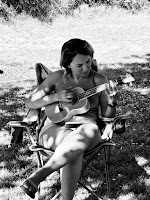A "yes" person.
I'm certainly getting better about this as I get older, but I've accepted that it's in my nature to make others happy. Sometimes to my own detriment.
"Ellie, can you help us design a new school mascot?" Sure. "Would you read my manuscript... again.?" You bet. "How about being the SCBWI guest blogger for the month of July, even though you're finding out about this in June?" Why not? (Actually, this last one has been a lot of fun and I'm going to miss posting!)
Now, I don't agree to anything that I know will make me miserable, and to be honest, I've gained a lot of opportunities and connections by being so darn agreeable. However, when it comes to my artistic vision versus an editors' desires for the work, it can be hard to know when and where to stand my ground.
These conflicts occur throughout the process of creating a book, from conception to publication, but I personally struggle with this most when resolving line art edits. Line art is a stage of book illustration that is more refined than loose sketches, but not all the way to full color, final art. Not all illustrators create line art, many go from sketches to finals, but I personally like this in-between stage as I think it results in fewer edits and changes of final art.
Most editorial suggestions are easily resolvable or ones where I can clearly see I've erred and need to fix my work. And I remind myself frequently, that at this point in my career, my editor and AD likely have many years of experience and many, many books under their belt. Their suggestions are the result of careful observation of what does and does not work in publishing. Not only that, but I have found that all the editors and ADs I've worked with are very considerate of the illustrator's vision, time, and energy and aren't capricious with their suggestions.
Sometimes however, I've made a particular choice as an artist because I think it elevates the work in some way and this is where I have the hardest time letting go. I want to be agreeable, but well, I also want my way. Case in point, the project I'm currently working on involves a highly anthropomorphized sea star. (He's complete with a mustache, windbreaker, and microphone. You're going to love him.) In one panel, the sea star is viewed from the back and you can see his grooves lined with many tiny tube feet. The editor feels this is coming across in an awkward way, but I think it's really funny to have something so realistic on such an anthropomorphized character.
In another project about monarch butterfly migration, I named a fictional school in the background after a murdered butterfly activist, Homero Gómez González. For me, this is an homage to a conservationist who selflessly worked to point out the dangers of tourism and logging to monarch populations. For the editor, there are potential legal issues with using the name and permissions may need to be considered. For the time being, they've asked me to leave the school without a name.

In another project about monarch butterfly migration, I named a fictional school in the background after a murdered butterfly activist, Homero Gómez González. For me, this is an homage to a conservationist who selflessly worked to point out the dangers of tourism and logging to monarch populations. For the editor, there are potential legal issues with using the name and permissions may need to be considered. For the time being, they've asked me to leave the school without a name.
So how does one decide where to stand one's ground or to give way? How do we balance our vision, while remaining "easy to work with?" Here are some questions I try to ask myself when making these decisions:
- Does my vision offer something unique to the work? What does it offer? (Humor, education, an opportunity for personal reflection, etc.)
- Do I have expertise or experience that lends my opinion more weight on this particular matter? (This is especially important with nonfiction work.)
- Is my decision based on personal or universal values? What values and why is that important to me?
- How much time and energy will be involved in making the change?
- If I make the requested change, how will I feel when I look at it (repeatedly) in the final product? Will I feel regret every time I turn to that page?
Regarding the sea star, I've decided to explain my reasoning for keeping it the way it is, while agreeing to try a couple different perspectives. I think it offers something unique, but not essential, and it won't bother me terribly if it doesn't make it in the final book. On the school naming, I'm still awaiting the editor's final say on the matter. It offers something educational for readers and I feel its inclusion manifests values of gratitude and integrity, enough so that it would be worth seeking permission, if it's needed.
What factors do you consider or questions do you ask when deciding the non-negotiables of your work? Please share in the comments below!

Ellie Peterson is an author and illustrator of many picture books including HOW TO HUG A PUFFERFISH and SCHOOL IS WHEREVER I AM and a rather poor player of the ukulele. Find out more about Ellie and her work at elliepetersonart.com.


Thanks for a wonderful month of blogging, Ellie. Glad you said "yes!"
ReplyDelete